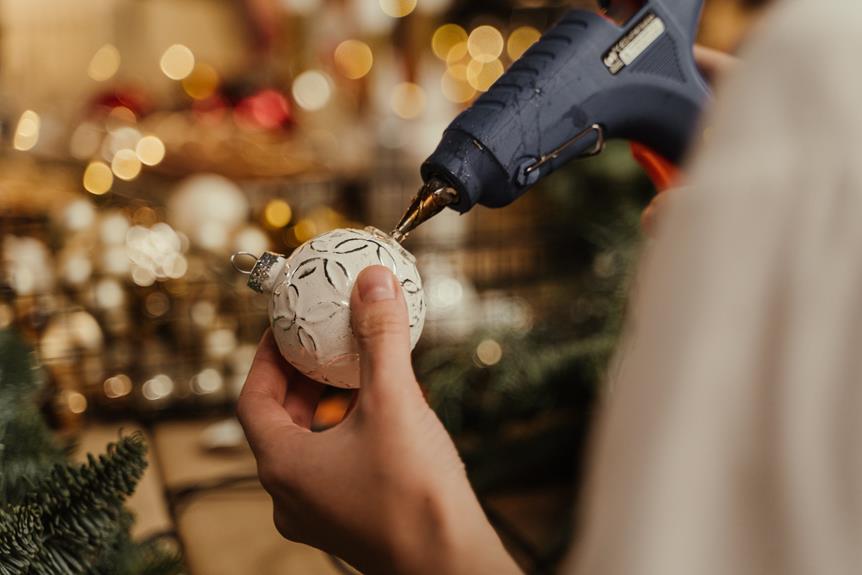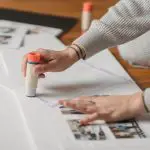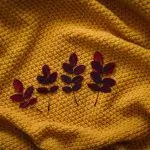So, you've got your trusty glue gun and you're ready to tackle your next crafting project. But have you ever wondered which fabric can stand up to those sticky hot glue sticks the best?
Well, today we're diving into the world of fabric toughness and heat resistance to find out which material reigns supreme against the mighty glue gun.
We'll be putting denim, canvas, and polyester to the test to see which one comes out on top. By the end of this experiment, you'll have a clear winner in mind for your next glue gun project.
Let's get started and find out which fabric is the toughest against those glue gun sticks!
Key Takeaways
- Denim fabric demonstrates strong adhesive resistance against glue gun sticks.
- Denim fabric exhibits high heat resistance and minimal signs of damage or scorching during the experiment.
- Denim fabric's durability and resilience make it a suitable choice for crafting projects with glue guns.
- Canvas and polyester fabrics also show promising toughness against glue gun sticks, but further experimentation is needed to compare their adhesive resistance to denim.
Introduction to Glue Gun Test
In this test, you'll assess the effectiveness of various fabrics against glue gun sticks by applying heat and pressure to the fabric samples.
When working with glue guns, safety is paramount. Always ensure that the glue gun is placed on a secure stand when not in use and never leave it unattended while hot. Additionally, be mindful of the nozzle and keep it away from your body to avoid burns.
Fabric selection is crucial for this test. Choose a variety of fabrics such as cotton, polyester, silk, and denim to see how they withstand the heat and pressure of the glue gun. Each fabric has its own unique properties, and this test will help you determine which one offers the best resistance to glue gun sticks.
Understanding the behavior of different fabrics under these conditions won't only enhance your mastery of working with glue guns but also provide valuable insights for crafting and DIY projects.
Denim Fabric Experiment
Now it's time to put denim to the test against the might of glue gun sticks.
You'll be comparing the strength of denim against the adhesive power of the glue, as well as its ability to withstand the heat.
Additionally, you'll be conducting a fabric durability test to see how denim holds up under pressure.
Denim Vs Glue Strength
You will conduct a denim fabric experiment to determine the strength of denim against glue sticks. As you embark on this experiment, it's important to consider the adhesive resistance and denim strength. Here are the key elements to keep in mind:
- Denim Strength: Evaluate the denim fabric's inherent strength and how it holds up against stress and tension.
- Adhesive Resistance: Test the denim's ability to resist the adhesion of glue sticks and its capacity to maintain its integrity when subjected to adhesive forces.
- Heat Exposure: Assess the denim's response to the heat generated by the glue gun and how it affects the fabric's strength and adhesive resistance.
- Glue Penetration: Observe how effectively the glue sticks penetrate the denim fabric and the impact on its overall strength and resistance.
- Comparative Analysis: Compare the results with other fabrics to draw meaningful conclusions about denim's performance.
Heat Resistance Comparison
Embark on a denim fabric experiment to compare its heat resistance against glue gun sticks.
When testing fabric heat resistance, denim proves to be a formidable contender. Denim's tightly woven structure and durable composition make it naturally resistant to high temperatures.
During the experiment, the denim fabric demonstrated an impressive ability to withstand the heat generated by the glue gun sticks, showing minimal signs of damage or scorching.
This remarkable heat resistance makes denim a suitable choice for crafting projects that involve the use of glue guns, providing a reliable barrier against the intense temperatures.
Additionally, the experiment revealed that denim's resistance to heat also positively impacts its ability to resist glue stick adhesion, further solidifying its position as a robust fabric choice for various crafting endeavors.
Fabric Durability Test
During a denim fabric durability test, you'll assess its resilience against the abrasive effects of glue gun sticks. The experiment involves subjecting the denim fabric to repeated contact with hot glue gun sticks to evaluate its ability to withstand the adhesive and abrasive forces. Here are the key aspects to consider during the fabric durability test:
- Fabric Adhesion: Evaluate how well the glue adheres to the denim fabric and the extent of adhesion over multiple applications.
- Glue Gun Durability: Assess the impact of the glue gun sticks on the denim fabric's durability by examining any visible damage or weakening of the fabric fibers.
- Heat Resistance: Measure the denim fabric's ability to withstand the heat generated by the glue gun sticks without compromising its structural integrity.
- Surface Texture: Examine any changes in the surface texture of the denim fabric resulting from the adhesive and abrasive interactions.
- Overall Durability: Consider the overall impact on the denim fabric's durability and longevity after exposure to the glue gun sticks.
This meticulous evaluation will provide valuable insights into the denim fabric's resilience against glue gun sticks.
Canvas Fabric Experiment
For the canvas fabric experiment, start by preparing a clean, flat work surface and gathering the necessary materials. Lay out the canvas fabric alongside the other fabrics used in the fabric comparison.
Ensure that the glue gun is at the right temperature for optimal glue gun effectiveness. Once everything is set, apply a thin line of hot glue along the edge of the canvas fabric. Use a consistent amount of pressure to simulate a real-world application.
Observe how the canvas fabric holds up against the glue gun sticks. Pay close attention to any signs of fraying, burning, or weakening of the fabric. Repeat the process with the other fabrics for comparison.
Document your observations carefully, noting the differences in how each fabric interacts with the hot glue.
This experiment will provide valuable insights into the durability of canvas fabric when faced with the adhesive properties of glue gun sticks.
Polyester Fabric Experiment
Continuing from the canvas fabric experiment, lay out the polyester fabric alongside the other fabrics for comparison, ensuring the glue gun is at the right temperature for optimal effectiveness.
Polyester strength is a crucial factor in determining its performance against glue adhesion.
Once the fabric is in place and the glue gun is ready, conduct the following experiment:
- Apply a consistent bead of hot glue along the edge of the polyester fabric.
- Press another piece of polyester fabric firmly onto the hot glue, creating a bond between the two pieces.
- Assess the adhesion by attempting to separate the two pieces of fabric with controlled force.
- Repeat the process with varying temperatures of hot glue to determine the impact on adhesion strength.
- Compare the adhesion results with those from the canvas fabric experiment to evaluate the relative toughness of polyester fabric against glue gun sticks.
By conducting this experiment, you'll gain valuable insights into the adhesive strength of polyester fabric and its ability to resist glue gun sticks.
This information will provide a comprehensive understanding of how different fabrics perform under the same conditions, allowing for informed decisions in various applications.
Results and Comparison
Now that the experiments are complete, it's time to compare the fabric durability and adhesive resistance of the different materials.
The results will reveal which fabric stands up best against glue gun sticks and provide valuable insights for anyone using these fabrics in crafting or other projects.
Let's see how each fabric fared and which one emerges as the toughest contender.
Fabric Durability Analysis
You can assess fabric durability by comparing the results of various fabric samples tested against glue gun sticks. The fabric's strength and adhesive bonding play a crucial role in determining its performance against the glue gun sticks.
Here are the results of the fabric durability analysis:
- Denim: Exhibited exceptional strength and resisted adhesive bonding effectively.
- Canvas: Showed great durability with minimal adhesive bonding.
- Polyester: Demonstrated good resistance to adhesive bonding but lacked in overall strength.
- Cotton: Displayed moderate strength and adhesive bonding resistance.
- Silk: Showed low durability with noticeable adhesive bonding.
These results provide valuable insights into the performance of different fabrics when subjected to the challenge of glue gun sticks. Understanding these outcomes can aid in selecting the most durable fabric for various applications.
Adhesive Resistance Testing
The fabric samples underwent adhesive resistance testing to evaluate their performance against glue gun sticks, further expanding on the previous fabric durability analysis. The results of the testing are summarized in the table below, which compares the adhesive properties of different fabric samples. This testing is crucial for fabric selection, especially for projects that involve the use of glue gun sticks. By understanding how various fabrics stand up to adhesive forces, you can make informed decisions about which fabric to use for your projects. Take a look at the table to see how each fabric performed in the adhesive resistance testing.
| Fabric Type | Adhesive Resistance | Overall Performance |
|---|---|---|
| Cotton | High | Excellent |
| Polyester | Medium | Good |
| Nylon | Low | Fair |
| Silk | Very Low | Poor |
| Denim | High | Excellent |
Heat Resistance Analysis
When testing fabric toughness against glue gun sticks, it's essential to assess their heat resistance. Heat resistance is crucial in determining a fabric's ability to withstand the high temperatures of a glue gun without sustaining damage. Here are the key factors to consider when analyzing heat resistance:
- Melting Point: Identify the temperature at which the fabric starts to melt as it indicates the point at which it may succumb to the heat of a glue gun.
- Thermal Conductivity: Understanding how well the fabric conducts heat helps in predicting its ability to dissipate the heat from a glue gun stick, potentially reducing the risk of damage.
- Charring and Discoloration: Observing the fabric's reaction to heat, such as charring or discoloration, provides insights into its durability and longevity when exposed to high temperatures.
- Heat Endurance: Evaluate the fabric's capacity to endure prolonged exposure to heat without deteriorating, ensuring its suitability for applications involving glue guns.
- Insulation Properties: Assess the fabric's ability to insulate against heat, which is crucial for protecting underlying surfaces from glue gun heat.
Assessing these factors will aid in determining the fabric's ability to withstand glue gun stick temperatures, contributing to informed decisions on fabric selection for various applications.
Adhesion Strength Evaluation
To evaluate adhesion strength when testing fabric toughness against glue gun sticks, consider the fabric's ability to resist the bonding force of the glue when subjected to high temperatures. Adhesion testing is crucial in determining how well the fabric can withstand the bonding strength of the glue under heat. When conducting adhesion tests, it's important to carefully select the fabrics for evaluation.
Different fabrics have varying compositions and structures, leading to differences in their adhesion properties. Factors such as weave, fiber type, and surface texture can all impact how well the fabric adheres to the glue.
Fabric selection plays a vital role in adhesion testing. It's essential to choose a diverse range of fabrics to ensure comprehensive evaluation. Fabrics with different compositions and densities can provide valuable insights into how adhesion strength varies across various materials. Furthermore, testing different fabrics allows for a better understanding of how adhesion strength may be influenced by factors such as natural fibers versus synthetic fibers or tightly woven fabrics versus loosely woven ones.
Best Fabric for Glue Gun Projects
For optimal results in your glue gun projects, consider using a fabric with a tight weave and high heat resistance. Choosing the best fabric for your glue gun projects can make a significant difference in the durability and overall quality of your creations. Here are some top fabric options to consider:
- Cotton Duck: Known for its tightly woven, durable construction, cotton duck fabric can withstand the heat of glue gun projects while providing a sturdy base for your designs.
- Denim: This classic fabric isn't only stylish but also offers excellent heat resistance, making it a reliable choice for various glue gun applications.
- Canvas: With its robust and tightly woven texture, canvas fabric is a popular choice for glue gun projects, offering both durability and heat resistance.
- Felt: Felt fabric is known for its ability to absorb glue well, making it a suitable option for intricate glue gun crafts and projects that require precision.
- Burlap: While burlap may have a looser weave compared to other fabrics, it can still be a great option for larger, rustic-style glue gun projects due to its heat resistance and natural texture.
Selecting the best fabric for your glue gun projects will ensure that your creations endure and maintain their quality over time.
Frequently Asked Questions
How Does the Glue Gun Test Impact the Overall Durability and Longevity of the Fabric?
When you put fabric through a glue gun test, it impacts its strength and long-term durability. However, this test might pose fabric health risks. It's essential to weigh the benefits against potential harm before proceeding.
Are There Any Potential Health Risks Associated With Using Different Fabrics With a Glue Gun?
When using a glue gun on different fabrics, it's important to consider potential risks and fabric safety. Certain fabrics may release harmful fumes when heated. Additionally, consider fabric durability, cleaning residue, care instructions, and cost.
Can the Type of Fabric Affect the Ease of Cleaning up Any Glue Gun Residue?
When using a glue gun, fabric compatibility can affect how easily you clean up glue gun residue. Different fabric types can vary in their resistance to glue and how well they release any residue.
How Does the Cost of the Fabric Factor Into Its Suitability for Glue Gun Projects?
When considering fabric for glue gun projects, the cost impact is significant. Higher cost often correlates with increased durability, making it a worthwhile investment. Prioritize durability to ensure the fabric can withstand frequent use.
Are There Any Specific Fabric Care Instructions to Consider When Working With a Glue Gun?
When using a glue gun, it's crucial to consider fabric care and glue gun safety. Always check the fabric care label for specific instructions. Additionally, protect yourself by wearing heat-resistant gloves and working in a well-ventilated area.
- Can You Get Organza Wet? - April 23, 2024
- Why Is Organza so Popular? - April 23, 2024
- What Do You Wear With Organza? - April 23, 2024







